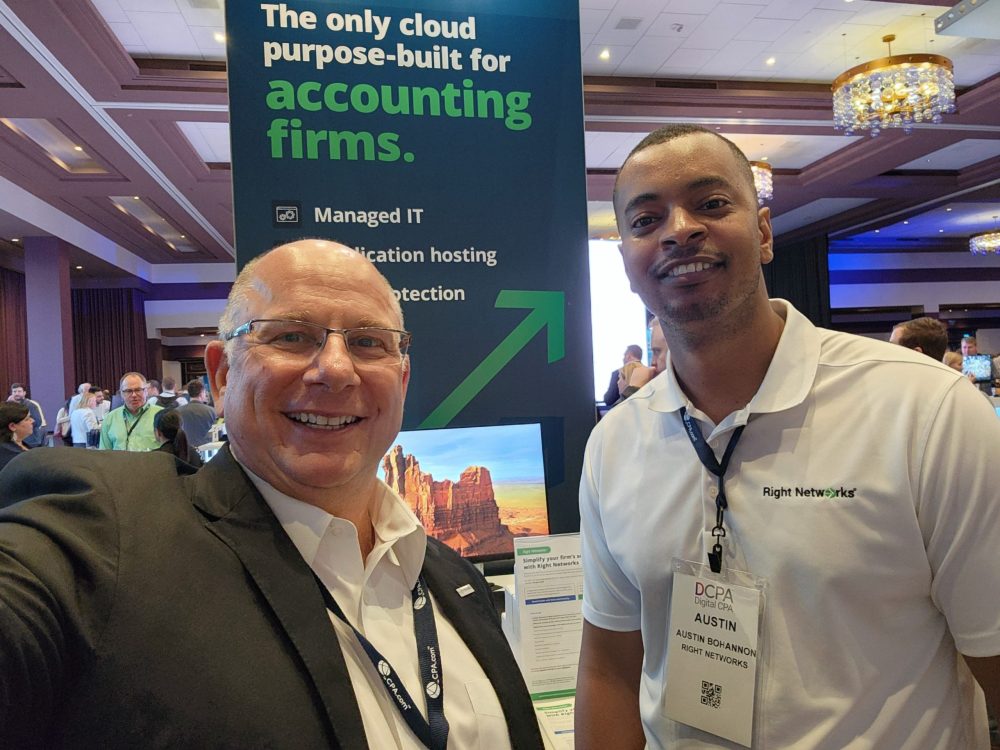The Digital CPA Conference 2022 just wrapped up in Austin, Texas. I was there, representing Right Networks, to take part in building the future of the accounting profession. A Right Networks team member, Austin Bohannon, joined me in participating along with approximately 1,000 onsite and 400 virtual attendees.
With multiple session tracks, topics and keynotes to choose from, it was impossible to cover everything. However, the over-arching themes were that Client Accounting and Advisory Services were the rising stars in firms and innovation. The future of the profession is being driven by a variety of innovative technologies and cloud-based business automation tools. These tools are improving all aspects of firm technology, including assurance and tax production practices.
I targeted sessions on innovation and change management, data analytics and reporting, and personal accountability. My highlights from the Digital CPA conference 2022 are summarized below:
Innovation
Innovation was one of the consistent themes throughout the conference. Larger firms are creating new positions to manage change with titles such as Chief Innovation Officer (CINO) and Chief Transformation Officer (CTO). These leaders are opening the door to innovation for their firms. They are asking their staff what specific areas they struggle with and providing opportunities to make “innovation requests.” The new positions are also identifying which tools might already exist in the marketplace, or they’re finding areas to develop and champion them in their firms.
Smaller firms are at an advantage in technological adoption today as they are more agile, requiring fewer people to change. They suggested allocating an annual budget for pursuing innovation. And then having firm innovators request funds to pursue solutions with the understanding that some of these attempts would fail. However, failed attempts are essential in the learning and identification process.
In the Tax Innovation session, specific areas listed for automation included: trial balance workflow for business returns, OCR of source documents, crypto tax collection and related workflow, tax return assembly and delivery, E-file notifications, and batch processing of tax extensions. For indirect tax, there were new tools mentioned that addressed areas such as sales and use tax compliance, location-based reporting, and e-invoicing – all touted as opportunities for innovation.
Data Analytics and Reporting
The collection and analysis of business information was a recurring theme in many sessions. The tools to do so are now reasonably accessible to any size firm. This suggests that it is important for every firm to designate personnel to help with the pursuit of collecting, manipulating, and reporting on data. Data tools Fathom and Microsoft Power BI were mentioned often. In addition, packaged reporting tools such as Qvinci, Jirav, Looker, and Reach Reporting were frequently named by firms already building dashboards.
One of my favorite quotes was that it is with “near certainty that machines will automate the collection of and processing of data but will NOT replace the advisory understanding and direction that accountants provide.” This supports the notion that the tools mentioned above and other APIs (application program interfaces that connect software products to transfer data) are becoming “consumer-grade,” meaning they are cost-effective and have less of a learning curve to adopt. The AICPA worked with Deloitte and Workday to create a reporting whitepaper called Frictionless Finance, outlining the strategy to innovate reporting and client advisory.
Life Skills Takeaway
While my primary focus is on accounting technology, my favorite keynote was from Marcus Buckingham, author of “Love + Work: How to Find What You Love, Love What You Do, and Do It for the Rest of Your Life.” His research showed that the most successful people “find love in the work they do” rather than the familiar adage, “do what you love to do and you’ll never work a day in your life.”
This means that much of the work we do does not bring great joy. However, there are certain components of daily work that we genuinely enjoy. It gives us specific vividness and makes us feel strengthened and invigorated. These are the tasks we complete without realizing the amount of time that has passed. The tasks that bring us joy and a feeling of accomplishment.
Some examples in my case:
- The feeling when I see that a client understands a new concept that I am advising them on
- “Nailing” the delivery of a presentation/webinar, learning about a cool new technology
- Completing an engagement (along with the delivery of the invoice)
Marcus points out that each of us needs to figure out what components of our work we love. And what gives us this feeling, and to find a way to have those items make up at least 20% of each of our working days. To identify these items, he suggested that you create two columns on a piece of paper. For the next week, write down the work you “love” and the work you “loathe.” Then, schedule more work you love. And automate or outsource the work you loathe.
My Digital CPA Conference 2022 Experience
While identifying conference themes and the underlying solutions are specific to the person attending sessions, I hope that I have added depth to your existing knowledge base, which impacts your personal and business strategies.

